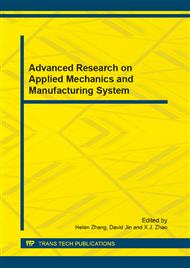p.144
p.149
p.154
p.158
p.162
p.167
p.172
p.176
p.181
Mechanism of Bio-Inspired Ultrasensitive Low Frequency Sensor with Mechanics Analysis
Abstract:
It is essential to develop ultrasensitive low frequency sensors for efficient structural health monitoring and early warning of natural disasters. Many fishes have been reported to have acute sensitivity to low frequency. Based on the mechanism of the infrasound sensitivity of fish, mechanism of bio-inspired ultrasensitive low frequency sensor is explored by a mechanical model with gating spring hypothesis for simulating the mechanical-electricity transduction of the hair cell in fish ear. Numerical analyses of the mechanical model subject to static and dynamic loading are conducted respectively by OpenSees. Under static loading, displacement response of gating model is more sensitive to weak loading due to the opening of gating spring. Under dynamic loading, the gating model is more acute sensitive to low frequency and weak loading due to the adaptive amplification of gating spring. This mechanical function can be used as the theoretical basis for the design of ultrasensitive bio-inspired low frequency sensors.
Info:
Periodical:
Pages:
162-166
Citation:
Online since:
December 2012
Authors:
Price:
Сopyright:
© 2013 Trans Tech Publications Ltd. All Rights Reserved
Share:
Citation:



